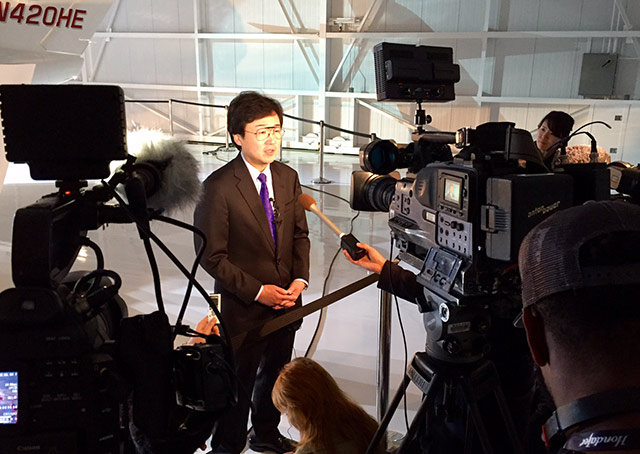
Another aviation first occurred in North Carolina on Dec. 9 when the FAA awarded a type certificate to Honda Aircraft’s first airplane, the HondaJet. Reminiscing of when he first saw the twin jet at EAA AirVenture when it was still in Experimental status, FAA Administrator Michael Huerta said to Honda Aircraft President and CEO Michimasa Fujino, “The experiment is over. Go fly!” The handing over of the type certificate at Honda’s Greensboro, North Carolina, factory brought some 2,000 employees, guests, and dignitaries to their feet and set off hundreds of confetti cannons.
The awarding occurred 12 years and a week after the proof-of-concept HondaJet first flew at Greensboro, nearly 20 years after Fujino first sketched the design on a calendar, and nearly 30 years after Honda first began research in Japan on small aircraft and jet engines. In what is perhaps the biggest understatement of the year, Fujino described the process of designing and certifying a clean-sheet business jet as an “extremely complex task.” The company has spent three decades, some $600 million in capital investments at Greensboro, and by some estimates $1.6 billion in total to bring the project through certification. First delivery of the $4.5 million jet is expected before the end of the year. The company won’t say how many orders it has but has confirmed it is more than 100.
With a top speed of 420 knots, the light jet promises to be a class leader in speed. Its cabin is also remarkably large for its overall size because the engines are mounted on top of the wings rather than on the aft fuselage. The move allows a much larger portion of the fuselage to be used for cabin space. The “over the wing engine mount” configuration also reduces drag, according to Fujino, who spent years studying the airflow around the fuselage to improve performance. The bulbous nose generates laminar flow, as do the thin wings.
The airplane is powered by a pair of HF 120 turbofans built by GE Honda Aero Engines, a partnership between GE and a sister company of Honda Aircraft. The engine project also is the famed automaker’s first foray into the aircraft engine business.
The gala evening was capped off by a performance by saxophonist Kenny G, himself a pilot who has flown the HondaJet. He, like others who have flown it, was impressed especially by the climb performance. At one point, Kenny invited Fujino back onto the stage to ask him what song he should close with. Fujino said he was a longtime Kenny G fan. He said he first discovered the saxophonist in 1993 when he was under pressure to fly his first airplane design, the MH-02, a research vehicle. He picked up Kenny G’s 1992 album Breathless and became particularly fond of the song Morning. “Because sometimes I felt like the morning would never come,” Fujino said, becoming emotional about the dedication and work he has put into his aviation career. “I respectfully request that you play Morning,” he said. The artist obliged.




